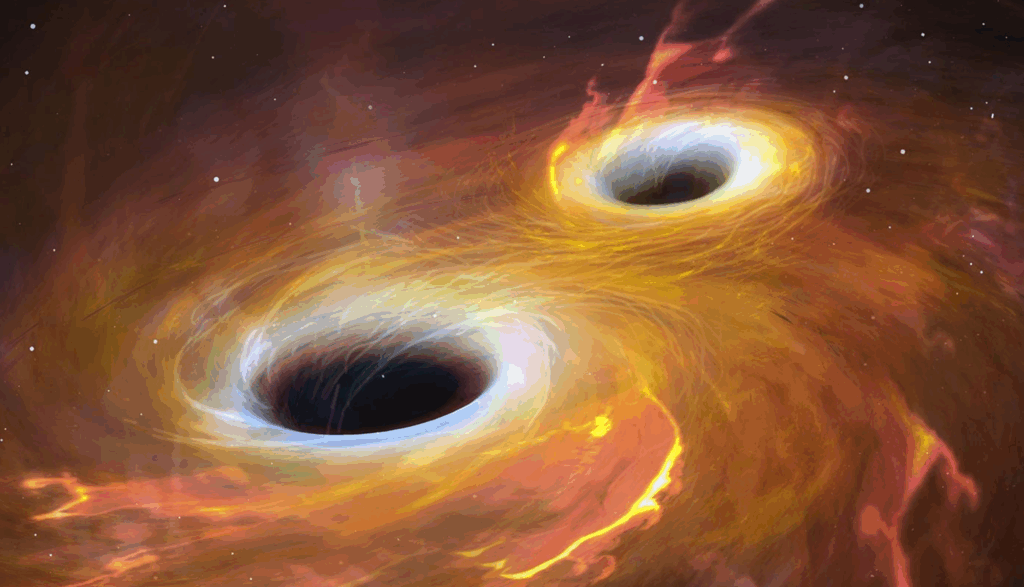
Astronomers have achieved a groundbreaking milestone by capturing the first-ever radio image of two supermassive black holes orbiting each other within a distant quasar named OJ 287. This historic observation, utilizing the orbiting RadioAstron satellite and radio telescopes on Earth, confirms a 40-year-old theory and opens unprecedented insights into the formation, movement, and collision of black holes.
OJ 287, located approximately 5 billion light-years away in the constellation Cancer, has long intrigued scientists with its peculiar, clocklike bursts of light. These periodic flashes, occurring every 12 years, hinted at the presence of not one but two black holes—a massive one with a mass exceeding 18 billion Suns and a smaller companion. The smaller black hole periodically plunges through the disk of gas surrounding its larger partner, causing abrupt flashes detectable even by amateur astronomers.
The Double Heart Quasar
The quasar OJ 287 stands out not only for its brightness but for its unique dual black hole system. “The quasar OJ 287 is so bright that it can be detected with a modest telescope,” explained Mauri Valtonen of the University of Turku in Finland, who led the research. “What makes it special is that we’ve known for decades it probably hosts two black holes, circling each other every 12 years and producing a recognizable light pattern.”
The journey to this discovery dates back to the 19th century when OJ 287 was inadvertently captured in early sky surveys. It wasn’t until 1982 that Aimo Sillanpää, then a graduate student at the University of Turku, recognized the repeating brightness cycle. He proposed that the cycle could only be explained by two gravitationally bound black holes, a theory initially met with skepticism but gradually accepted as more data supported it.
Bringing the Invisible into Focus
Traditional optical telescopes lack the resolution to distinguish between two black holes billions of light-years away. To overcome this, astronomers employed very long baseline interferometry (VLBI), which combines radio telescopes on Earth to function as a single massive device. By incorporating the RadioAstron satellite, which travels halfway to the Moon, they achieved a resolution 100,000 times greater than conventional optical instruments.
When this system focused on OJ 287, it revealed three radio bright spots. Two of these spots corresponded to the predicted positions of the double black holes, while the third was a knot in one of their jets—streams of high-speed particles ejected from near the black holes’ poles. “They themselves are completely black,” Valtonen described. “But the jets they produce are cosmic lighthouses. They help us to locate and identify the two objects.”
The Wagging Jet of a Restless Companion
One of the most striking discoveries is the twisted jet of matter emanating from the smaller black hole. Unlike the steady jet of its larger counterpart, this jet “wriggles” as it travels, creating a spiral effect akin to water from a spinning hose. This phenomenon, known as the “wagging tail” effect, results from the smaller black hole’s rapid movement through distorted space.
“This is the first time we’ve actually seen such a jet in a system like this,” Valtonen said. “It’s an entirely new phenomenon that tells us a lot about how jets respond to motion and gravity.” Researchers anticipate that as the smaller black hole alters its velocity and position, the jet’s direction will also change, providing a direct view of the complex gravitational dance of these celestial giants.
Decades of Prediction Finally Proven
The debate over whether OJ 287 contained two supermassive black holes has persisted for over 40 years. Previous observations, including those by NASA’s TESS satellite, suggested dual light sources but lacked the resolution to confirm them. This new radio image resolves that debate, placing the black holes precisely where models predicted.
“The two black holes were exactly where the models had said they would be,” Valtonen stated. “That agreement between theory and observation is extremely reassuring to us about how these systems work.”
This finding validates decades of global scientific effort, involving millions of nights of observation and research. It confirms that binary black holes are not merely theoretical but can be directly observed, offering valuable evidence of galaxy collisions and their evolution over time.
Beyond the Image: What This Means for Science
Capturing an image of two supermassive black holes in orbit is not merely a technical achievement but a scientific breakthrough. Binary black holes are believed to be the remnants of colliding galaxies, slowly converging over millions of years before merging in a burst of gravitational waves. OJ 287 provides a glimpse of this process in action.
By studying the interactions of these black holes and their jets, astronomers can refine accretion physics models and test Einstein’s general theory of relativity in its most extreme conditions. The precise timing of OJ 287’s flares has already been used to test models of gravitational energy loss, effects so subtle they can only be detected in such systems.
“This is an astronomical lab in which to see gravity at its strongest,” Valtonen said. “It’s showing us not just about black holes but about how the universe works.”
Practical Implications of the Research
The success of this imaging campaign paves the way for studying black hole pairs throughout the universe. Future, more advanced telescopes could observe these systems over millions or billions of years, tracking their approach and eventual coalescence.
Through these observations, scientists will be able to predict and interpret the gravitational waves produced by such mergers—ripples in spacetime already detected by LIGO and Virgo. Beyond pure science, this achievement demonstrates human ingenuity and technology’s ability to expand the boundaries of sight. By linking a satellite halfway to the Moon with ground-based telescopes, researchers have shown that collaboration and persistence can unveil what was once hidden.
For humanity, this accomplishment brings us closer to understanding the formation of galaxies, the creation of black holes, and the fundamental role of gravity in the universe. The research findings are available online in The Astrophysical Journal.







